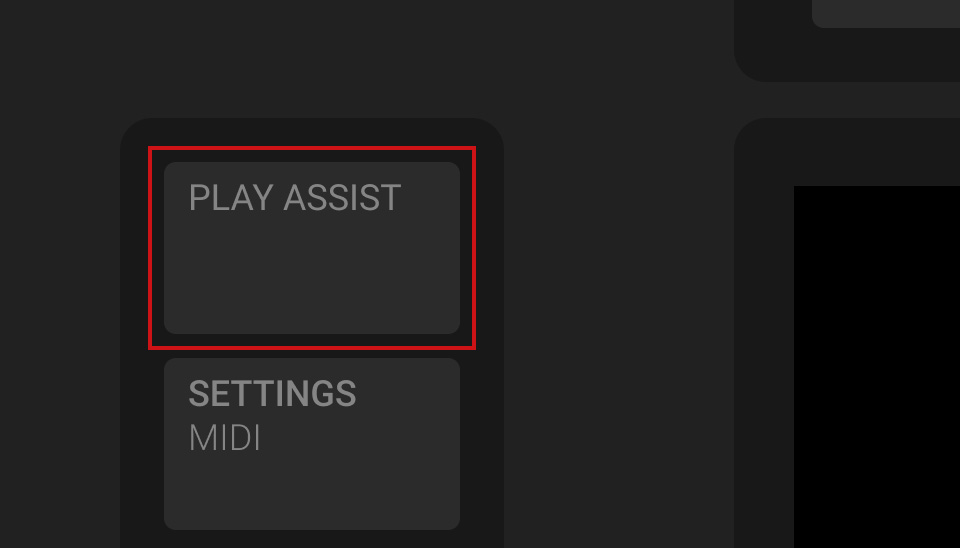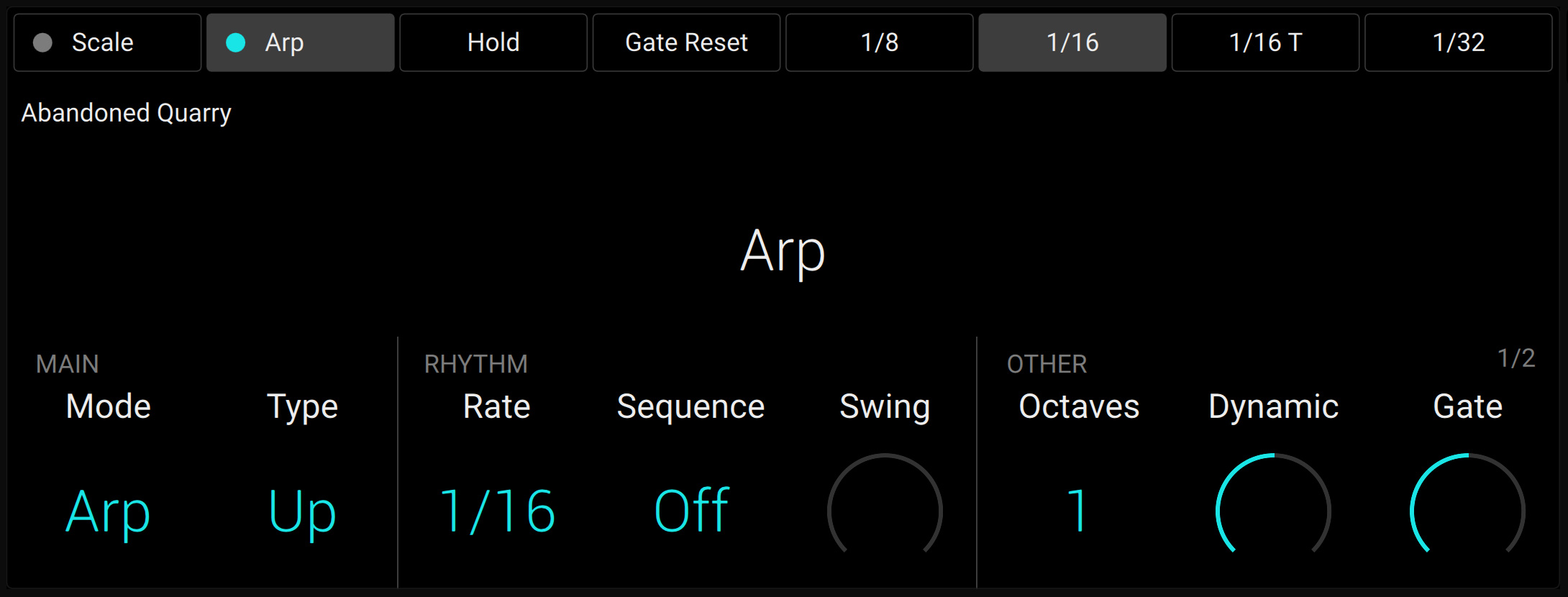Arpeggiator
The Arpeggiator enables you to automatically generate musical sequences according to the notes you play using your Kontrol S-Series MK3 keyboard. It features a vast amount of different motives and rhythms that you can use to play your instruments.
The Arpeggiator enables you to automatically generate musical sequences according to the notes you play using your keyboard or sequencer. It features a vast amount of different motives and rhythms that you can use to play your instruments. Combined with the Scale engine, you can play motives and rhythms while also constraining the notes to the selected scale.
Activating the Arpeggiator
Playing the Arpeggiator
Using Arpeggiator Snapshots on the Keyboard
The Arpeggiator snapshots let you quickly recall four sets of Arpeggiator settings. This way you can compare settings, or quickly switch between them during a performance. On the keyboard, the snapshots are mapped to Button 5–8 above the display. Below the buttons, they are labeled with their respective settings for the RATE parameter (e.g., 1/8, 1/16, 1/16 T, etc.).
To select an Arpeggiator snapshot, press the corresponding button above the display.
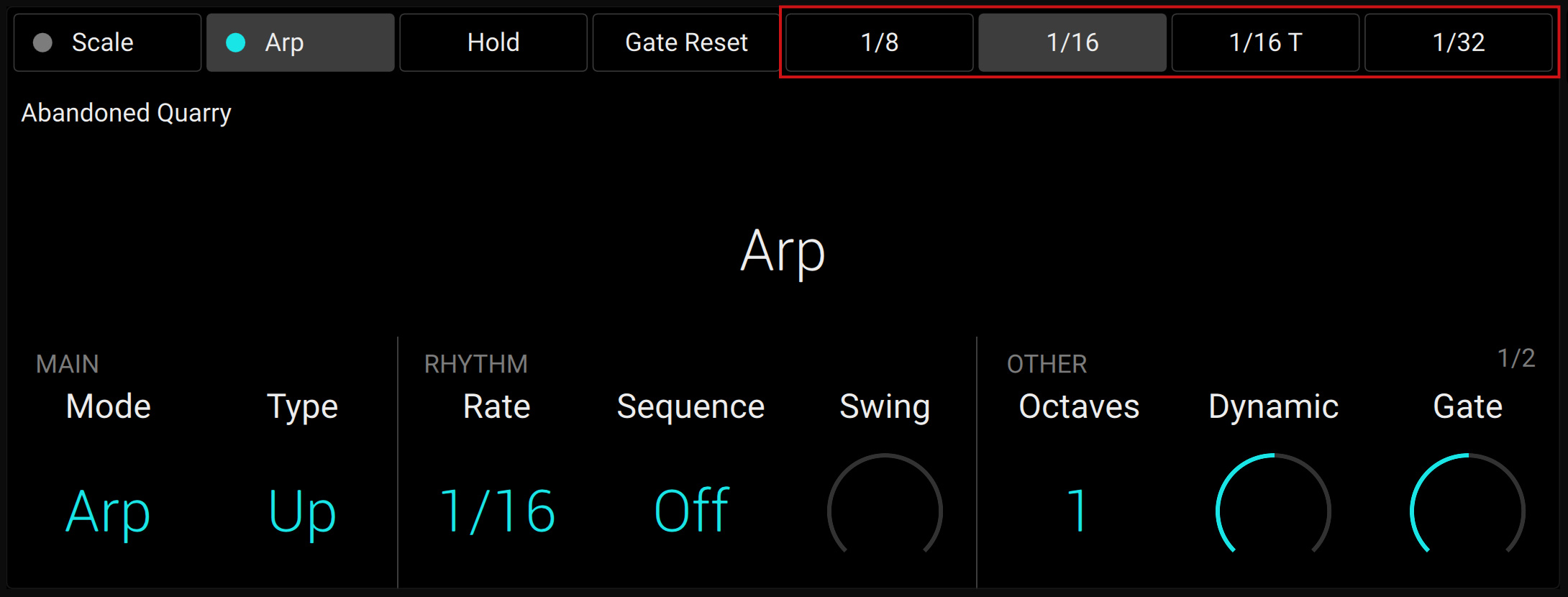
All Arpeggiator settings associated with this snapshot are instantly recalled.
To change the settings associated with an Arpeggiator snapshot, select it and adjust the parameters.
The new settings are saved automatically, and you can switch forth and back between Arpeggiator snapshots to recall them.
Editing the Arpeggiator
The Arpeggiator parameters give you many possibilities to shape your own note sequences.
You can switch between Arp and Note Repeat mode and change the playback direction of the arpeggiator sequence by using the MAIN parameters Mode and Type. For more information, refer to Main Parameters.
You can create interesting rhythms for the arpeggiator sequence by using the RHYTHM parameters Rate, Sequence, and Swing. For more information, refer to Rhythm Parameters.
You can change the range of available notes for the arpeggiator sequence, as well as their velocity and length, by using the OTHER parameters Octaves, Dynamic, and Gate. For more information, refer to Other Parameters.
You can explore alternative versions of the same arpeggiator sequence by using the ADVANCED parameters Retrigger, Repeat, Offset, and Inversion. For more information, refer to Advanced Parameters.
You can change the range of keys that trigger the arpeggiator sequence by using the RANGE parameters Min. Key and Max. Key. For more information, refer to Range Parameters.
You can latch the playback of the arpeggiator sequence by using the Hold parameter. For more information, refer to Hold Parameter.
Accessing the Arpeggiator Parameters
To access the Arpeggiator parameters on your keyboard, do the following:
Check that the PLAY ASSIST button is brightly lit. If not, press it to display the parameters for the Scale and Arp engines.
Press Button 2 (Arp) to display the Arpeggiator parameters.
The Button 2 lights up brightly and the Arp label below Button 2 is highlighted, indicating that you are editing the Arpeggiator parameters.
Tip
When the PLAY ASSIST button is on, the Button 2 color indicates whether the Arp engine is on (cyan) or off (white), while its brightness indicates if the Arp parameters are displayed (brightly lit) or not (dimmed).
The Arpeggiator parameters might spread over multiple pages. You can switch between pages using the Page buttons at the left of the display:
Press the Page buttons (left and right arrows) at the left of the display to switch to another page of parameters:
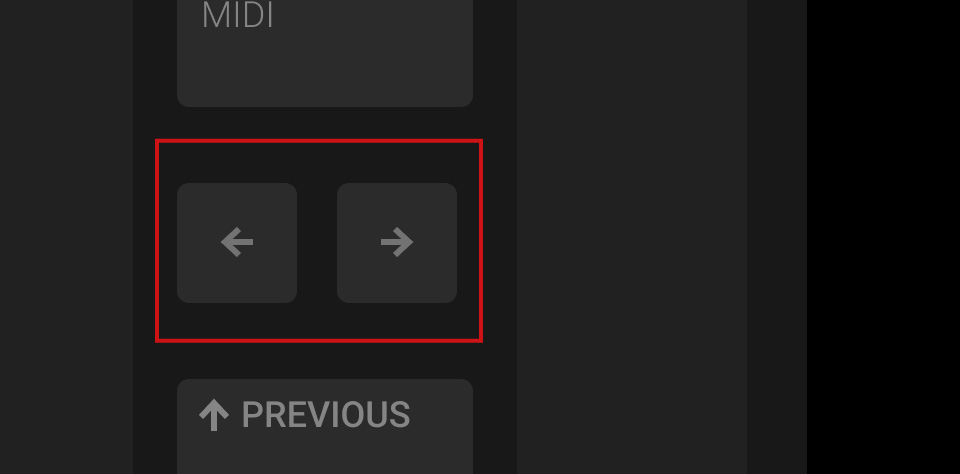
The display and the Knobs 1–8 switch to the next or previous set of parameters.
A dim lit Page button indicates that another page can be displayed by pressing the button.
The gray numbers at the far right on the display indicate the current page and the total number of pages available:
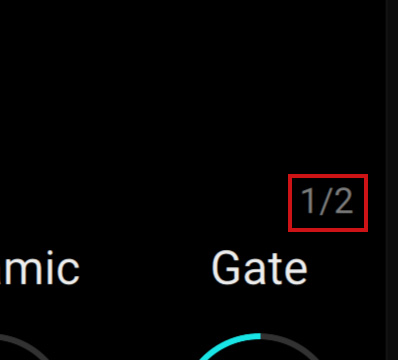 |
Main Parameters
The MAIN parameters Mode and Type allow you to switch between Arp and Note Repeat mode and change the playback direction of the arpeggiator sequence.
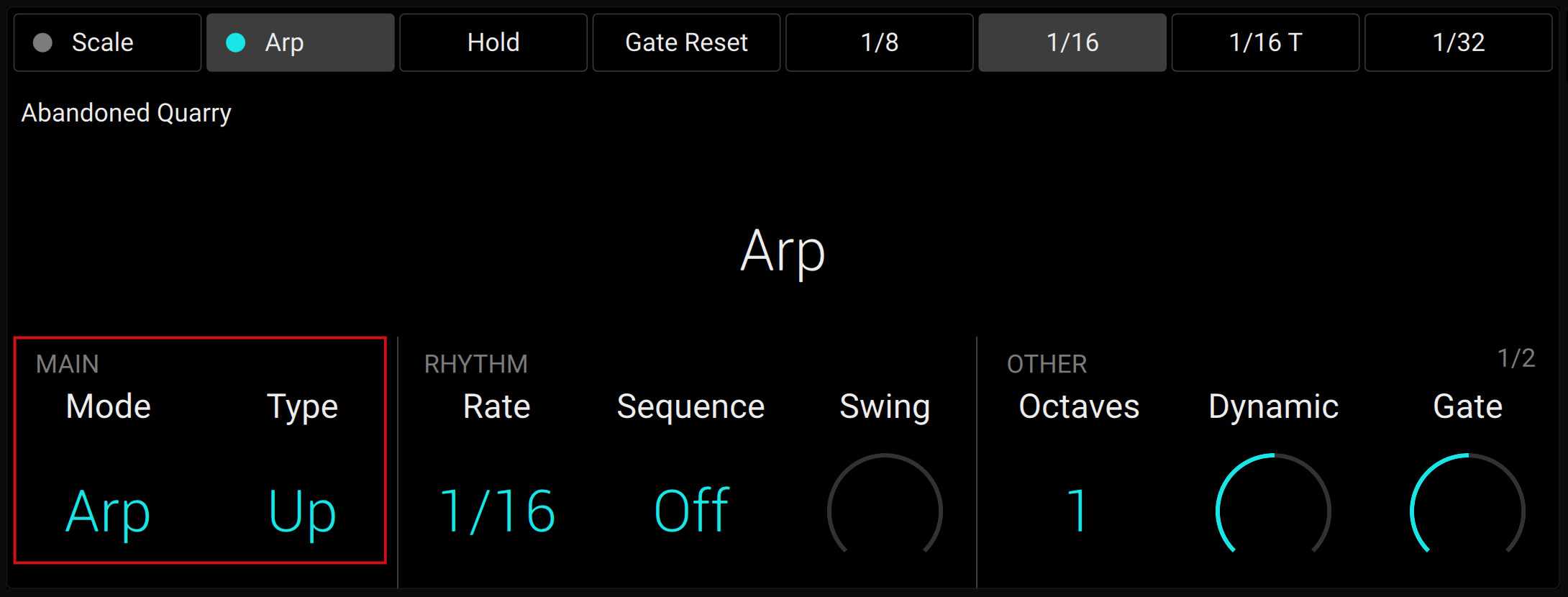
The MAIN parameters Mode and Type.
Main Mode
The first MAIN parameter is Mode. lt lets you select either Arp or Note Repeat. Depending on your selection, a different set of Arpeggiator parameters will be available for further editing.
The Mode setting consists of the following two modes:
Arp mode, which generates arpeggiator sequences based on chords you play on the keyboard, or the output of the Scale engine. With the Arpeggiator switched on and Mode set to Arp, any chord you created using the Scale engine will play as an arpeggiated note sequence. In this case, you only need to press one key on the keyboard to hear the arpeggiated notes play out according to the selected scale.
Note Repeat mode, which deactivates the Arpeggiator and instead repeats whichever note is input until Komplete Kontrol receives a MIDI note-off message. Use the parameters Rate, Swing, and Gate to change the rhythm of the repeats.
Main Type
The second MAIN parameter, Type, is only available in Arp mode. It sets the sequential order of the arpeggiated notes. Choose whether your arpeggiated chord should be played from the root note and up, the other way around, or even simultaneously. Selecting Order Played will play back the notes in the order you pressed down the corresponding keys on the keyboard. Automating the Type parameter in the DAW can create interesting variations and textures.
The Type setting includes the following values:
Up, Down, Up & Down, Order Played, Chord
Rhythm Parameters
The RHYTHM parameters Rate, Sequence, and Swing allow you to create interesting rhythms for the arpeggiator sequence.
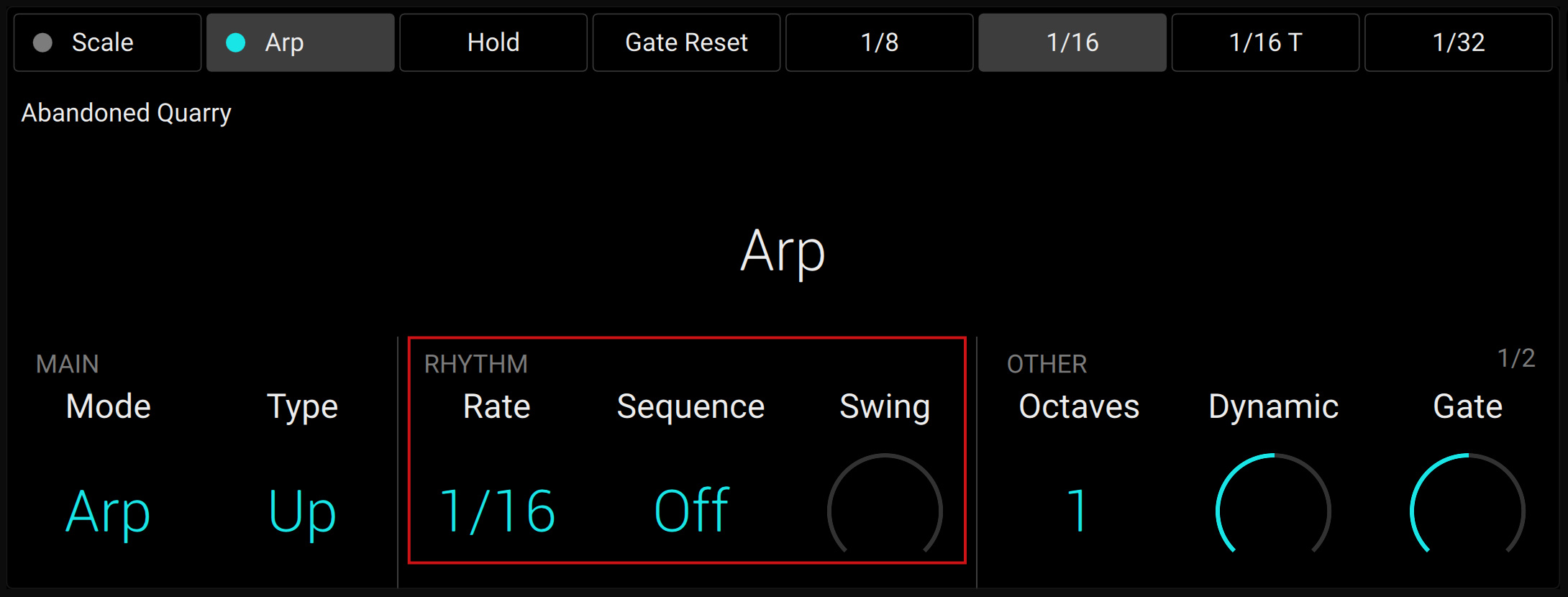
The RHYTHM parameters Rate, Sequence, and Swing.
Rhythm Rate
The first RHYTHM parameter, Rate, is available in both Arp and Note Repeat mode. It sets the beat of the Arpeggiator in relation to global tempo in musical values, ranging from 1/1 to 1/128. All note values (except 1/1 and 1/128) are available as basic notes, dotted notes, and triplets. Dotted notes are 1.5 times longer than the corresponding basic notes. Triplets are 2/3 the duration of their corresponding basic notes, so that e.g., three 1/4 notes are equal in duration to two basic 1/4 notes.
The Rate setting includes the following values:
1/1
1/2 Dotted (1/2 D)
1/1 Triplet (1/1 T)
1/2
1/4 Dotted (1/4 D)
1/2 Triplet (1/2 T)
1/4
1/8 Dotted (1/8 D)
1/4 Triplet (1/4 T)
1/8
1/16 Dotted (1/16 D)
1/8 Triplet (1/8 T)
1/16
1/32 Dotted (1/32 D)
1/16 Triplet (1/16 T)
1/32
1/64 Dotted (1/64 D)
1/32 Triplet (1/32 T)
1/64
1/128 Dotted (1/128 D)
1/64 Triplet (1/64 T)
1/128
Rhythm Sequence
The second RHYTHM parameter, Sequence, is only available in Arp mode. It gives you a way of adding interesting rhythms to your arpeggiated notes. Select one of eight different sequences and apply it to the arpeggiator sequence you are playing. Combine Sequence with the Rate parameter to create a huge variety of rhythms at different tempos. If Rate is set to a basic or dotted value, then Sequence applies a 16-step sequencer to the notes. If Rate is instead set to a triplet value, then Sequence applies a 12-step sequencer to the notes.
You can switch sequences in real time during playback. For example, if sequence 1 is running and you instead select sequence 2 after the fourth MIDI note in a pattern has been played back, then sequence 2 starts when the fifth MIDI note in the pattern is played back.
The Sequence setting includes the following values:
Off, 1, 2, 3, 4, 5, 6, 7, 8
Rhythm Swing
The third RHYTHM parameter, Swing, is available in both Arp and Note Repeat mode. Adding Swing to your note sequence can make it feel less quantized and sound more natural. Swing works by introducing a delay to every second note in a sequence. Doing so often adds a certain groove to the music.
Swing lets you set a value between 0% and 100%:
Set a value of 0% to play the note sequence without swing.
Increase the Swing value to add swing by delaying every second note. The delay length is a percentage of the current step size.
Using Swing in combination with the Gate parameter adds further variations in note duration. For example, if Gate is set to 100%, Komplete Kontrol sends a MIDI note-off message before each note and plays back the sequence legato. If Gate is set to values larger or smaller than 100%, then notes will be scaled after the value of the Swing parameter has been applied, leaving the groove intact.
Other Parameters
The OTHER parameters Octaves, Dynamic, and Gate allow you to change the range of available notes for the arpeggiator sequence, as well as their velocity and length.
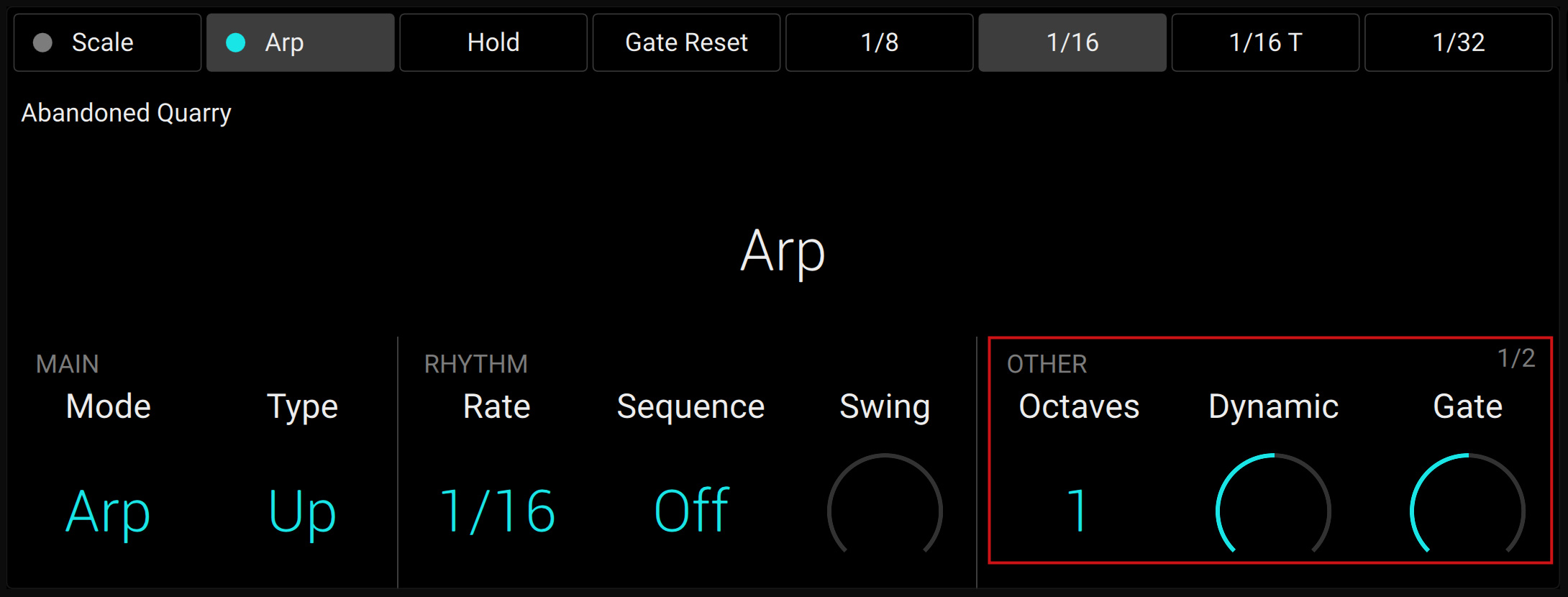
The OTHER parameters Octaves, Dynamic, and Gate.
Other Octaves
The first OTHER parameter, Octaves, is only available in Arp mode. It lets you decide the range of the arpeggiator sequence. You can choose to play back your sequence within the octave of only the keys you pressed on the keyboard, or you can select up to eight octaves and let the corresponding notes of your chord or scale be played back in as many octaves.
Depending on the settings you have made to the Type parameter, the octaves played back can be above (e.g., Up), below (e.g., Down) or both above and below (Up & Down) the pressed keys.
The Octaves setting includes the following values:
1, 2, 3, 4, 5, 6, 7, 8
Other Dynamic
The second OTHER parameter, Dynamic, is only available in Arp mode. It reads the velocity of the input (a key you pressed on the keyboard or an incoming MIDI note from the DAW) and scales it by the factor you set with the Dynamic parameter. The scaling is applied per note. The velocity of each played note is taken and multiplied by the value set with the Dynamic parameter.
Dynamic lets you set a value between 1.0% and 200.0%.
Other Gate
The third OTHER parameter, Gate, is available in both Arp and Note Repeat mode. It lets you decide the length of the notes in your sequence. Setting a value between 1% and 99% makes the duration of the notes shorter than they otherwise would be. Setting a value between 101% and 200% instead elongates the duration of the notes.
Gate lets you set a value between 1.0 % and 200.0 %.
Gate Reset
The Gate Reset function, mapped to Button 4 above the display, lets you reset the Gate parameter to its default value of 100 % at any time.
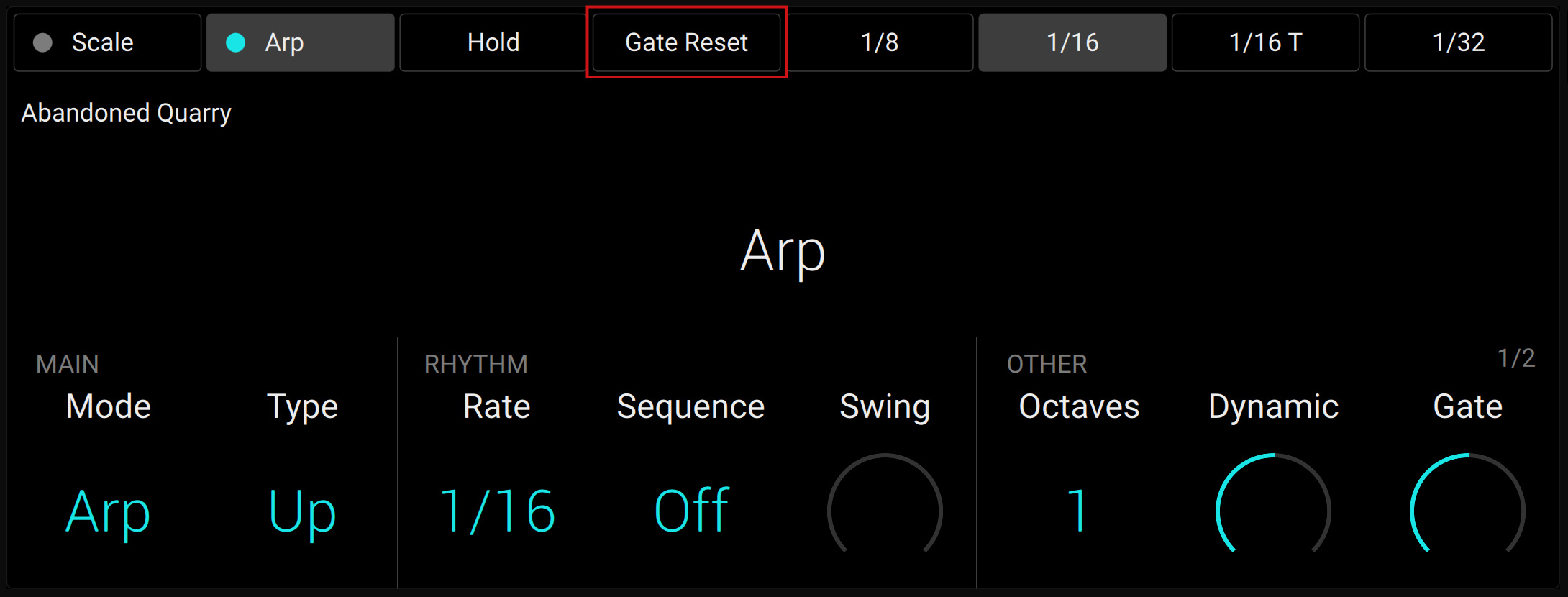
The Gate Reset function.
Advanced Parameters
The ADVANCED parameters Retrigger, Repeat, Offset, and Inversion allow you to explore alternative versions of the same arpeggiator sequence.
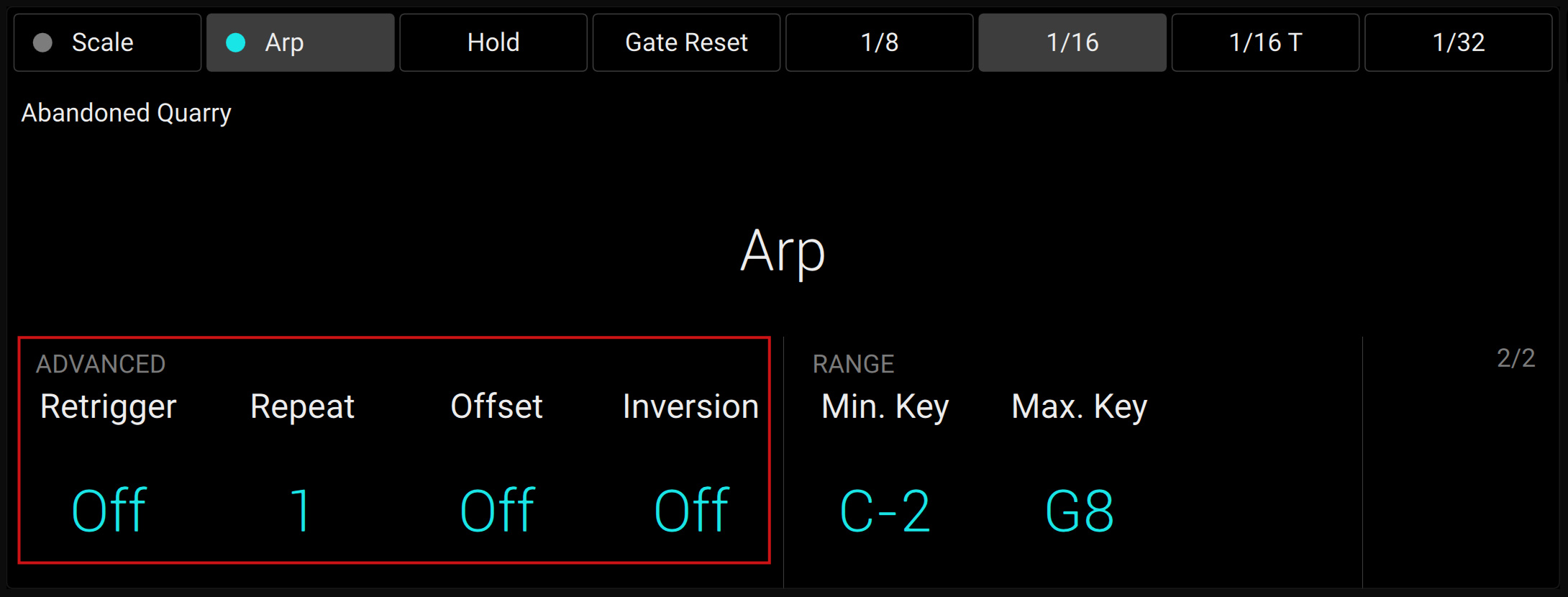
The ADVANCED parameters Retrigger, Repeat, Offset, and Inversion on page 2.
Advanced Retrigger
The first ADVANCED parameter, Retrigger, is only available in Arp mode. Retrigger sets a number of steps in the arpeggiator sequence after which the sequence restarts its cycle, regardless of the number of pitches in the sequence.
For example:
If the arpeggiator sequence consists of a 5 note cycle (1 - 2 - 3 - 4 - 5) and Retrigger is set to 3, the Arpeggiator output is 1 - 2 - 3 - repeat.
If the arpeggiator sequence consists of a 5 note cycle (1 - 2 - 3 - 4 - 5) and Retrigger is set to 8, the Arpeggiator output is 1 - 2 - 3 - 4 - 5 - 1 - 2 - 3 - repeat.
Rests in a Sequence are treated as steps:
If the arpeggiator sequence consists of 6 pitches, the Sequence is 1 - 2 - 3 - rest - 4 - 5 - 6 – rest, and Retrigger is set to 5, the Arpeggiator output is 1 - 2 - 3 - rest - 4 -repeat.
Advanced Repeat
The second ADVANCED parameter, Repeat, is only available in Arp mode. Repeat sets a number by which each step in the arpeggiator sequence is repeated.
For example:
If the arpeggiator sequence consists of a 3 note cycle (1 - 2 - 3) and Repeat is set to 3, the Arpeggiator output is 1 - 1 - 1 - 2 - 2 - 2 - 3 - 3 - 3 - repeat.
Advanced Offset
The third ADVANCED parameter, Offset, is only available in Arp mode. Offset sets a number by which the steps in the arpeggiator sequence are shifted in the cycle.
For example:
If the arpeggiator sequence consists of a 5 note cycle (1 - 2 - 3 - 4 - 5) and Offset is set to 0, the Arpeggiator output is 1 - 2 - 3 - 4 - 5 - repeat.
If the arpeggiator sequence consists of a 5 note cycle (1 - 2 - 3 - 4 - 5) and Offset is set to +1, the Arpeggiator output is 2 - 3 - 4 - 5 - 1 - repeat.
If the arpeggiator sequence consists of a 5 note cycle (1 - 2 - 3 - 4 - 5) and Offset is set to -1, the Arpeggiator output is 5 - 1 - 2 - 3 - 4 - repeat.
Advanced Inversion
The fourth ADVANCED parameter, Inversion, is only available in Arp mode. Inversion adds inverted alternations of the arpeggiator sequence to the cycle.
For example:
If the arpeggiator sequence consists of a 3 note cycle (1 - 2 - 3), Type is set to Up, and Inversion is set to 0, the Arpeggiator output is 1 - 2 - 3 - repeat.
If the arpeggiator sequence consists of a 3 note cycle (1 - 2 - 3), Type is set to Up, and Inversion is set to 1, the Arpeggiator output is 1 - 2 - 3 - 2 - 3 - repeat.
If the arpeggiator sequence consists of a 3 note cycle (1 - 2 - 3), Type is set to Up, and Inversion is set to 2, the Arpeggiator output is 1 - 2 - 3 – (2 - 3 - 1 octave up) - (3 - 1 - 2 octave up) - repeat.
Range Parameters
The RANGE parameters Min. Key and Max. Key allow you to change the range of keys that trigger the arpeggiator sequence.
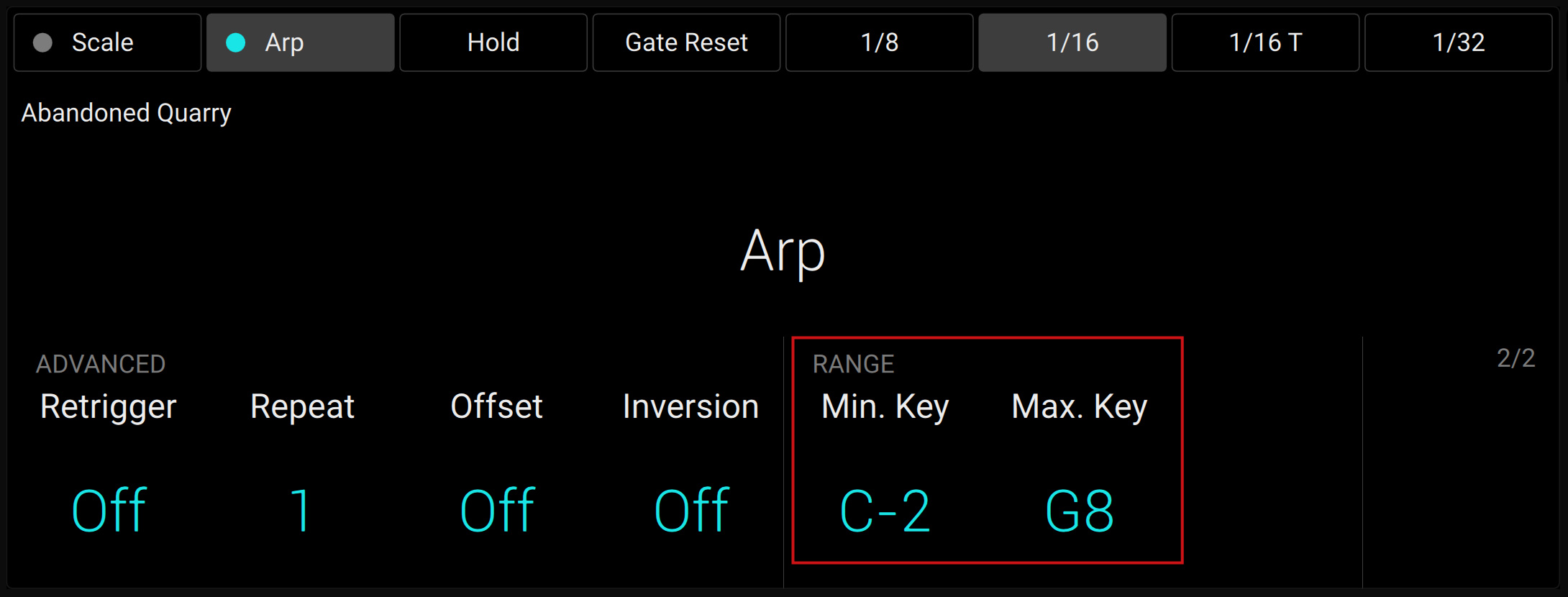
The RANGE parameters Min. Key and Max. Key on page 2.
Range Min. Key
The first RANGE parameter, Min. Key, is only available in Arp mode. Min. Key sets the lowest key that can be used as an input for the arpeggiator sequence.
Tip
The Arpeggiator can still generate pitches below the Min. Key setting.
Range Max. Key
The second RANGE parameter, Max. Key, is only available in Arp mode. Max. Key sets the highest key that can be used as an input for the arpeggiator sequence.
Tip
The Arpeggiator can still generate pitches above the Max. Key setting.
Hold Parameter
The Hold parameter is available in both Arp and Note Repeat mode. The Hold feature allows you to latch the notes played by the Arpeggiator. When Hold is active, the Arpeggiator will continuously play a sequence according to the last pressed keys on the keyboard.
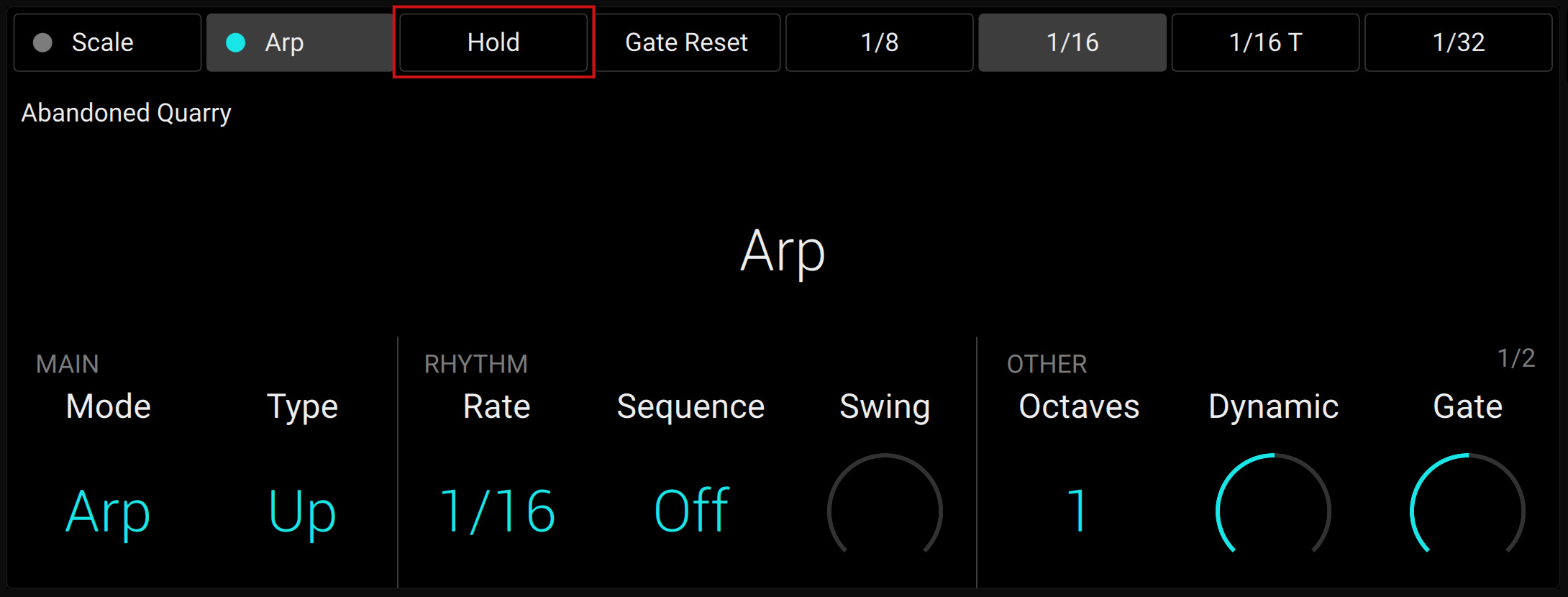
The Hold parameter.
Pressing any key while Hold is active will set a new sequence.
To stop the Arpeggiator playback, deactivate Hold.
Tip
Alternatively, you can switch the Arpeggiator completely off to stop playback. When you switch the Arpeggiator back on, Hold will still be active and you can continue to play latched note sequences with the Arpeggiator.
